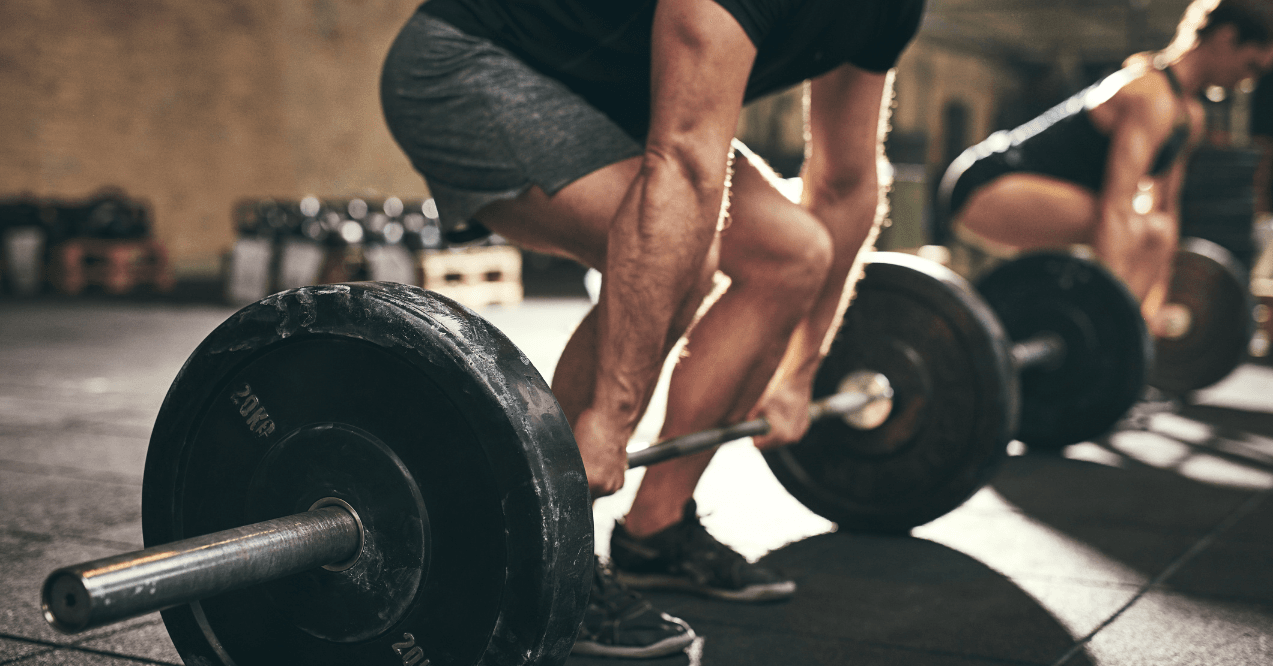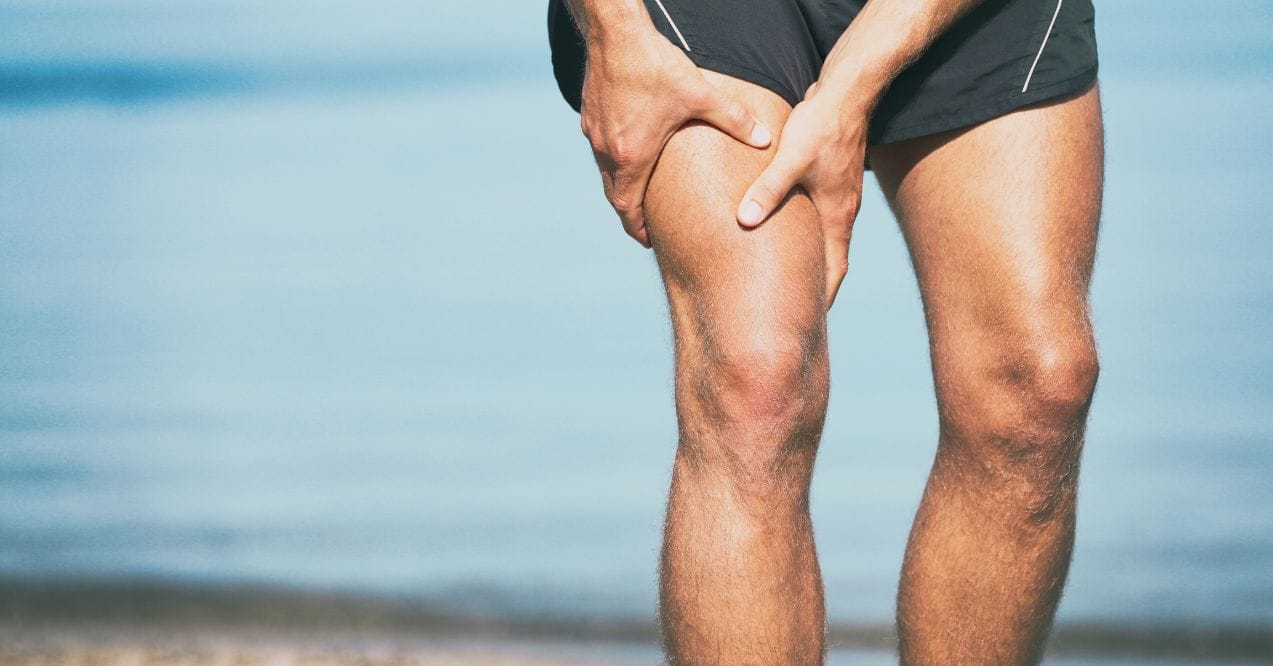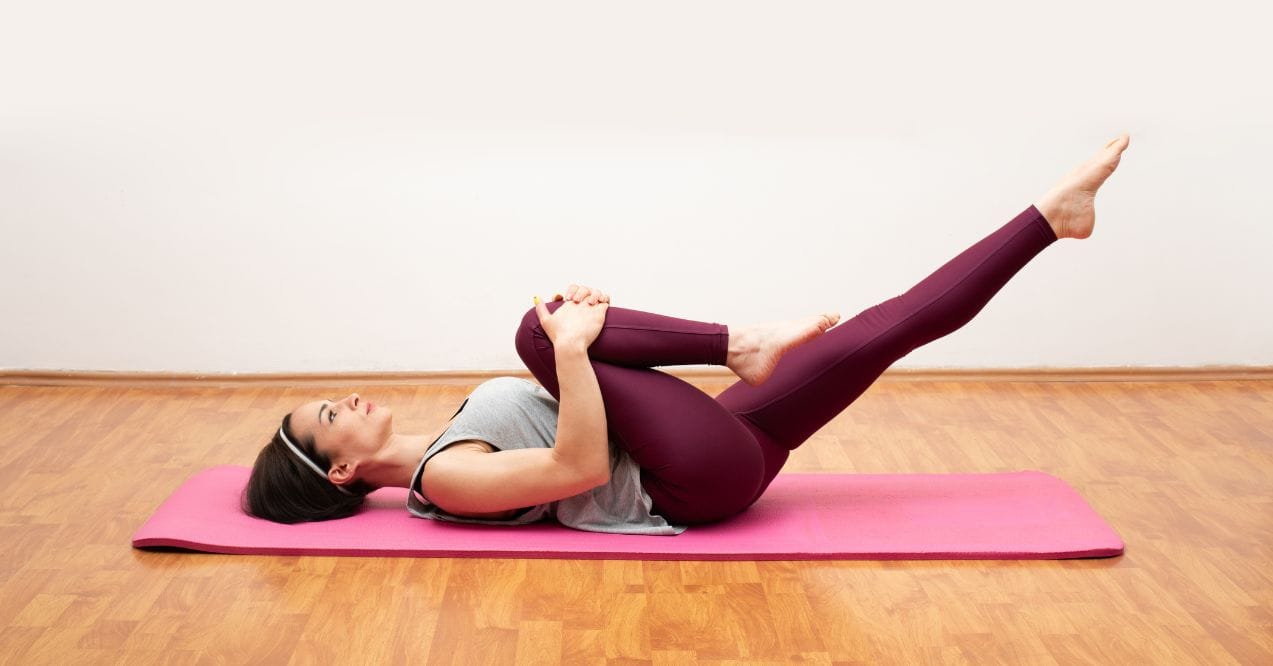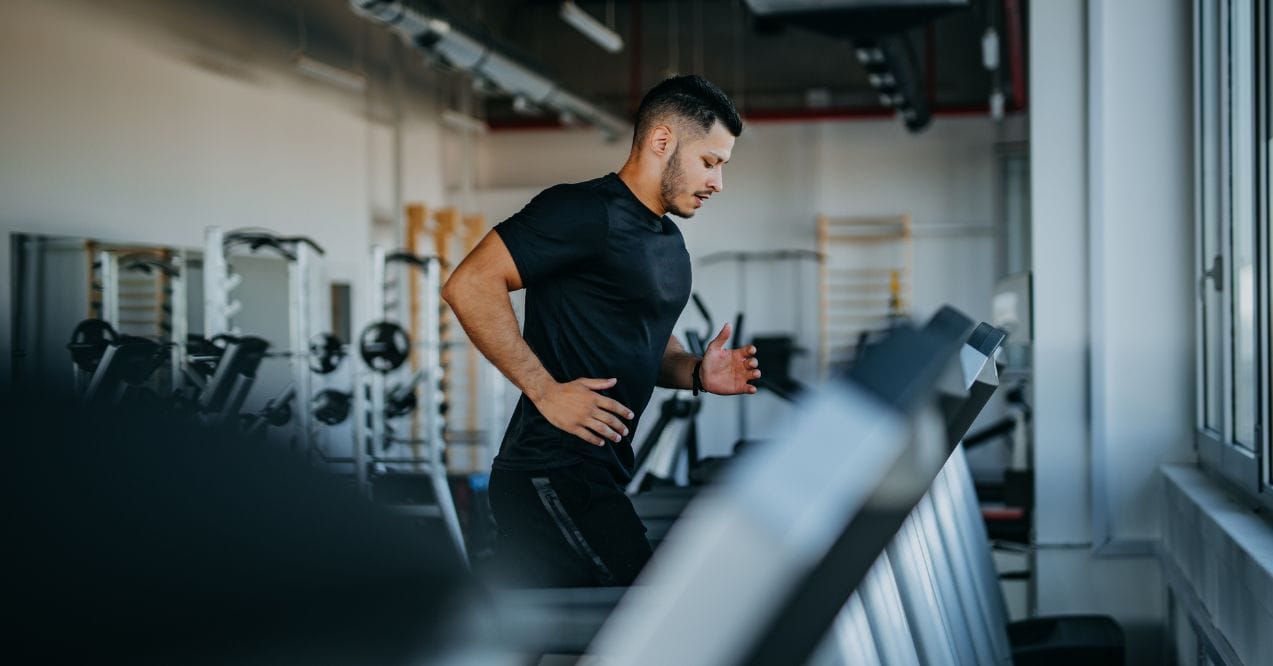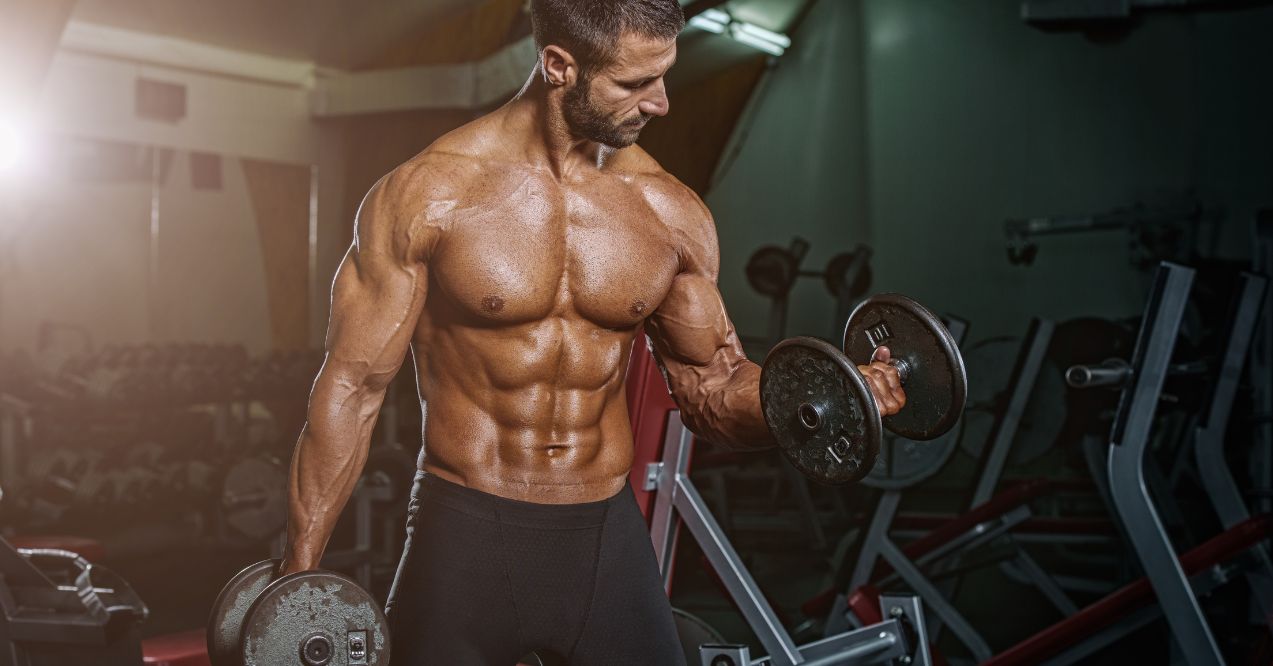Maximize Your Leg Gains with These Lower Body Pull Exercises
Lower body pull exercises form the foundation of any well-rounded fitness routine, offering numerous benefits for strength development and overall physical performance. These movements target the posterior chain muscles – the powerful muscle groups along the back of your body – and may significantly improve your strength, posture, and athletic capabilities when performed correctly.
By incorporating the right lower body pull exercises into your workout regimen, you can develop a balanced physique while potentially reducing injury risk. This guide walks you through everything you need to know about these essential movements, from proper form to programming suggestions.
What’s a Pull Exercise?
Pull exercises engage muscles through a pulling motion, as opposed to push exercises that work muscles through pushing actions. For lower body pull exercises, the focus lies primarily on the posterior chain – the muscles running along the back of your body from your calves to your upper back.
Unlike pushing movements such as squats and lunges that primarily target the quadriceps, lower pull exercises emphasize the hamstrings, glutes, and lower back. These exercises typically involve a hip hinge pattern where you bend at the hips while maintaining a neutral spine. When you perform leg pull exercises, you’re essentially pulling weight toward your body or pulling your body against resistance.
What makes pull exercises unique is how they activate muscles during the concentric phase (when muscles shorten). In pull exercises, you feel the most tension when the target muscles contract and shorten – for example, when you stand up during a deadlift or extend your hips in a glute bridge.
Benefits of Lower Body Pull Exercises
Adding a list of pull exercises to your workout routine may provide numerous advantages for your fitness journey:
- Balanced Strength Development – Pull exercises may counter the quad-dominant training many people default to, creating better muscle balance throughout the legs.
- Improved Posture – Regular training of the posterior chain may help correct posture issues caused by sitting for long periods. This can be especially helpful if you’ve noticed your legs feeling so heavy after a workout, which might be a sign of muscular imbalance.
- Reduced Back Pain Risk – Strengthening the glutes and hamstrings may take pressure off the lower back during daily activities.
- Enhanced Athletic Performance – Pull exercises at home or in the gym may improve your ability to run, jump, and change direction quickly.
- Better Functional Movement – The hip hinge pattern found in many lower body pull exercises mirrors movements used in daily activities.
- Increased Posterior Chain Activation – These exercises effectively target often-neglected muscles like the hamstrings and glutes.
- Potential Injury Prevention – Building balanced leg strength may reduce the risk of common injuries in sports and daily life.
Supporting Your Training Journey with Quality Nutrition
Proper nutrition helps fuel your lower body pull workouts and recovery. Bone Broth Protein from Trumeta provides protein with collagen, which is a major component of your joints and connective tissues. This may be helpful when your training puts stress on these areas.
For those looking to enhance their training, Trumeta Creatine is one of the most researched sports supplements available and may help improve performance during high-intensity exercises.
5 Most Important Lower Body Pull Exercises
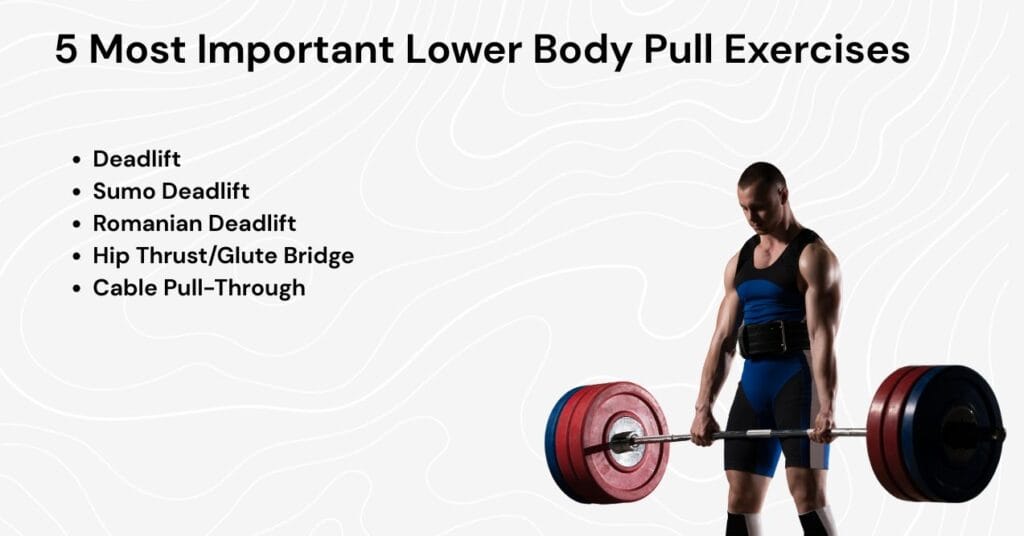
The foundation of any effective lower body training program should include several key pull exercises. These movements each offer unique benefits while collectively providing comprehensive development of your posterior chain muscles. Whether you’re training for aesthetics, strength, or performance, mastering these five lower body pull exercises will form a solid foundation for your fitness journey.
While many gym-goers debate the merits of hack squat vs leg press for quad development, having a balanced approach that includes these posterior chain exercises is equally important. Let’s explore these essential movements that should be included in any list of pull exercises for maximum results.
1. Deadlift
The deadlift stands as perhaps the most fundamental lower body pull exercise in existence. This compound movement primarily targets the hamstrings, glutes, and erectors while also engaging the entire posterior chain. The conventional deadlift involves lifting a barbell from the floor to hip level while maintaining a neutral spine.
What makes this exercise so valuable is its ability to load the legs heavily while also building tremendous core stability. For beginners, learning proper deadlift form should be a top priority as it sets the foundation for many other pull exercises.
How to perform Deadlift:
- Stand with feet hip-width apart with the barbell positioned over mid-foot
- Bend at the hips and knees to grip the bar with hands shoulder-width apart
- Lower your hips and lift your chest to create a flat back position
- Take a deep breath, brace your core, and push through your heels
- Keep the bar close to your body as you stand up
- Extend your hips and knees fully at the top position
- Lower the weight by hinging at the hips first, then bending the knees
- Control the bar all the way back to the floor
Sample Deadlift Routine:
- Beginners – 3 sets of 5 reps at 60-70% of max capacity, resting 2-3 minutes between sets
- Intermediate – 4 sets of 5 reps, gradually increasing weight with each set, with 90-second rest periods
- Advanced – 5 sets of 3-5 reps at 75-85% of max capacity, with 2-minute rest periods
2. Sumo Deadlift
The sumo deadlift variant uses a wider stance with toes pointed outward, shifting emphasis to the inner thighs and glutes. By positioning your feet further apart, you create a more upright torso position compared to the conventional deadlift.
This variation may be more comfortable for those with limited mobility or longer torsos. The sumo stance reduces the range of motion slightly, which may allow for heavier loads while placing less stress on the lower back. This makes it an excellent addition to any rotation of lower pull exercises.
How to perform Sumo Deadlift:
- Take a wide stance with feet turned out at approximately 45 degrees
- Position the barbell directly over the middle of your feet
- Bend at the hips and knees to grip the bar with hands positioned inside your legs
- Lower your hips and lift your chest while keeping your spine neutral
- Pull your shoulder blades down and back to create tension
- Push the floor away with your legs while keeping your chest up
- Keep the bar close to your body throughout the movement
- Fully extend your hips and knees at the top position
- Return the weight to the floor by reversing the movement pattern
Sumo Deadlift Routine:
- Beginners – 3 sets of 8 reps with light to moderate weight, focusing on form and stance width
- Intermediate – 4 sets of 6 reps at 65-75% of max capacity, with 2-minute rest periods
- Advanced – Work up to a heavy set of 5 reps, then perform 3 back-off sets at 70% of that weight for 8 reps
3. Romanian Deadlift
The Romanian deadlift (RDL) differs from conventional deadlifts by starting from a standing position rather than the floor. This variation places intense focus on the hamstrings and glutes while minimizing quad involvement. The key to an effective RDL is maintaining a slight knee bend throughout the movement while hinging at the hips and keeping the bar close to your body.
This exercise may significantly improve hamstring flexibility while building strength in the posterior chain. For those looking to develop their hamstrings, the RDL should be a staple in their lower body pull exercises routine.
How to perform Romanian Deadlift:
- Start in a standing position holding a barbell at hip level
- Set your feet hip-width apart with a slight bend in your knees
- Brace your core and maintain this knee bend throughout the exercise
- Hinge at the hips by pushing your buttocks backward
- Lower the barbell by sliding it down your thighs, keeping it close to your body
- Continue lowering until you feel a significant stretch in your hamstrings
- Maintain a flat back throughout the entire movement
- Return to standing by driving your hips forward
- Squeeze your glutes at the top of the movement
Romanian Deadlift Routine:
- Beginners – 3 sets of 10 reps with lighter weight, focusing on feeling the hamstring stretch
- Intermediate – 4 sets of 8-12 reps at moderate weight with 60-90 second rest periods
- Advanced – 3 sets of 8 reps with heavier weight, followed by a drop set of 12-15 reps at 60% weight
4. Hip Thrust/Glute Bridge
Hip thrusts and glute bridges are potent exercises that primarily target the gluteal muscles. The hip thrust utilizes a bench to support your upper back, while the glute bridge is performed entirely on the floor. Both movements involve extending your hips upward against resistance, creating maximal glute contraction at the top position.
These exercises are valuable for developing hip extension strength, which carries over to sprinting, jumping, and other athletic movements. They’re also among the most effective pull exercises at home for those without access to specialized equipment.
How to perform hip thrusts:
- Sit on the floor with your upper back against a bench
- Place a barbell across your hips (use padding for comfort)
- Position your feet flat on the floor, shoulder-width apart
- Brace your core and drive through your heels
- Extend your hips upward until your body forms a straight line from shoulders to knees
- Squeeze your glutes hard at the top position
- Lower your hips back to the starting position with control
How to perform glute bridges:
- Lie on your back with knees bent and feet flat on the floor
- Position feet hip-width apart, heels about 6 inches from your buttocks
- Rest arms at your sides with palms facing down
- Push through your heels and raise your hips off the ground
- Lift until your body forms a straight line from shoulders to knees
- Squeeze your glutes tightly at the top
- Lower with control back to the starting position
Hip Thrust/Glute Bridge Routine:
- Beginners – 3 sets of 15 bodyweight glute bridges with a 2-second hold at the top
- Intermediate – 4 sets of 12 hip thrusts with moderate weight and 1-minute rest periods
- Advanced – 4 sets of 8-10 heavy weighted hip thrusts, followed by 20 bodyweight pulses at the top
5. Cable Pull-Through
The cable pull-through serves as an excellent accessory exercise for practicing the hip hinge pattern while strengthening the hamstrings and glutes. Using a cable machine provides consistent tension throughout the movement, which may enhance muscle activation. The exercise involves standing with your back to the cable machine, pulling the cable between your legs, and then extending your hips forward. This movement reinforces proper hip hinge mechanics while reducing spinal loading compared to barbell exercises, making it a valuable addition to any lower body pull routine.
How to perform Cable Pull-Through:
- Set a cable machine to the lowest setting and attach a rope handle
- Stand facing away from the machine with feet shoulder-width apart
- Reach between your legs and grab the rope with both hands
- Step forward until there’s tension in the cable
- Maintain a slight bend in your knees throughout the movement
- Hinge at your hips by pushing your buttocks backward
- Allow your torso to lean forward while keeping your back flat
- Lower until you feel a stretch in your hamstrings
- Drive your hips forward to return to the starting position
- Squeeze your glutes at the top of the movement
Cable Pull-Through Routine:
- Beginners – 3 sets of 12-15 reps with light weight, focusing on the hip hinge pattern
- Intermediate – 4 sets of 10-12 reps with moderate weight and 45-second rest periods
- Advanced – 3 sets of 8-10 heavy reps, followed by a superset with 15 bodyweight glute bridges
Muscles Involved in Lower Body Pull Movements
Knowing which muscles you’re working helps you get more from your lower body pull exercises. Let’s break down the main muscle groups:
- Your glutes (butt muscles) are the powerhouse of your lower body. They help you stand up, climb stairs, and jump. The largest of these muscles, the gluteus maximus, does most of the work during pull exercises.
- Hamstrings run along the back of your thighs. These muscles help bend your knee and extend your hip during movements like deadlifts and Romanian deadlifts.
- The erector muscles that run along your spine keep your back straight during exercises. They act like support cables, making sure you maintain good form.
- When you do sumo stance exercises, you’ll also feel your inner thigh muscles (adductors) working. Your core muscles jump in too, keeping your trunk stable while you lift.
- Even your upper back gets involved, especially during deadlifts where it helps you maintain a strong position throughout the movement.
By working all these muscles with different lower pull exercises, you build strength that helps in everyday life and sports. This full-body approach makes sure all your muscles develop evenly instead of some getting too strong while others lag behind.
Common Mistakes in Lower Body Pull Exercises
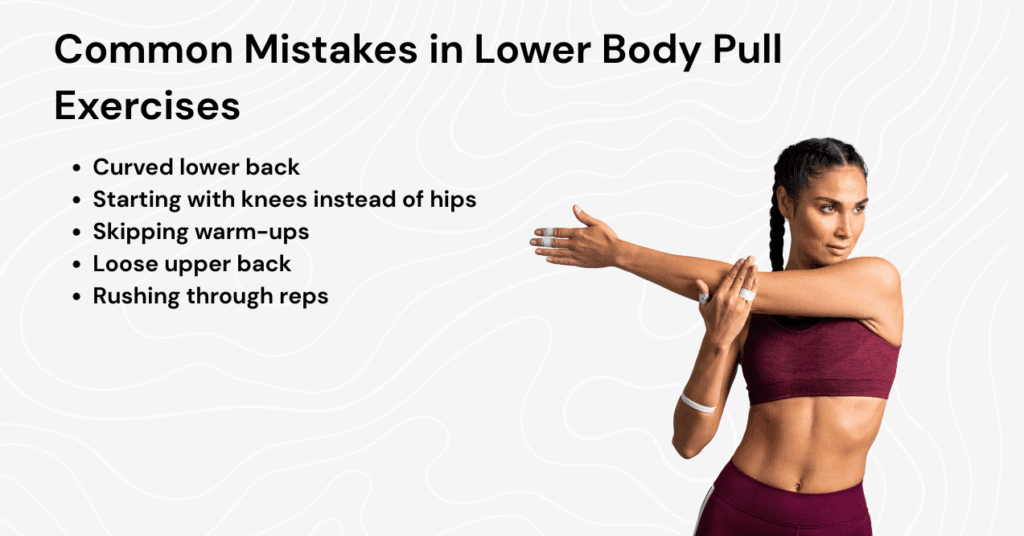
Even gym veterans make mistakes with lower body pull exercises. Let’s look at the most common errors and how to fix them:
Curved lower back – Many people round their back during hip hinge movements. This puts stress on your spine instead of working your muscles. Keep your back flat by tightening your core muscles throughout the exercise.
Starting with knees instead of hips – When you begin the movement by bending your knees first, you end up working your quads instead of your hamstrings and glutes. Always start the movement by pushing your hips back.
Skipping warm-ups – Jumping into heavy lifts without warming up is asking for trouble. Start with light stretches and a few easy sets before going heavy. This helps avoid knee and ankle pain that often comes from cold muscles.
Loose upper back – Your upper back needs to be tight during pull exercises. Before you lift, pull your shoulders down and back to create a solid base for your movement.
Rushing through reps – Going too fast means less muscle growth. Control the weight on the way down (the lowering part), as this is when your muscles get stronger.
Conclusion
Lower body pull exercises form an essential component of any well-rounded fitness regimen. By focusing on the posterior chain – the glutes, hamstrings, and erectors – these movements may help create balanced strength, improve posture, and enhance athletic performance. The five key exercises covered (deadlift, sumo deadlift, Romanian deadlift, hip thrust/glute bridge, and cable pull-through) provide a solid foundation for developing your lower body.
Start with lighter weights to master the techniques before progressively increasing the load. By avoiding common mistakes and understanding the muscle groups involved, you’ll maximize the benefits of your leg pull exercises while minimizing injury risk.
FAQs
Pull exercises involve muscle contraction when bringing weight toward your body or pulling against resistance. Push exercises work muscles as you move resistance away from your body. Pull targets posterior chain muscles while push typically works anterior muscles.
Common mistakes include rounding the lower back, initiating movement with knees instead of hips, inadequate warm-up, failing to engage the upper back, and rushing through repetitions. Focus on proper form and controlled movements for better results.
Yes, lower body pull exercises may help reduce back pain by strengthening the glutes and hamstrings, which support the spine. Proper form is essential, though, and those with existing back issues should consult a healthcare provider first.
Advertisement. This site offers health, wellness, fitness and nutritional information and is designed for educational purposes only. You should not rely on this information as a substitute for, nor does it replace, professional medical advice, diagnosis, or treatment. If you have any concerns or questions about your health, you should always consult with a physician or other health-care professional. Do not disregard, avoid or delay obtaining medical or health related advice from your health-care professional because of something you may have read on this site. The use of any information provided on this site is solely at your own risk.
